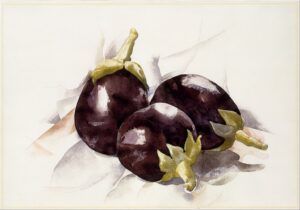Despicable eggplant. A vegetable’s trajectory from “Jewish food” to staple of Italian cuisine
As a Sephardic Jew whose mother is a first-generation Italian-American, eggplant parm was a frequent sight on my kitchen table at home. When celebrating the High Holidays, we often ate what we referred to as ‘Sephardic’ eggplant, which was essentially fried eggplant with fresh tomato sauce. These first-hand experiences led me to believe that the eggplant was adored by Italians and Jews alike. And while this may now be true, it is not the whole story of the eggplant in Italy. In fact, the eggplant was not always a beloved vegetable in Italian cuisine; it was once a food that disgusted many Italians. Today, the eggplant is a commonly used vegetable in Italian gastronomy, and can be found in a myriad of dishes in many regions of Italy. Sephardic Jews, originally from Spain and Portugal, made their way to Italy in the late 15th and 16th centuries. Long before their arrival in Italy, Sephardic Jews had been cooking with eggplant, which had likely been brought to the Iberian peninsula by the Arabs in the eighth century.
For these Iberian Jews the eggplant filled the role of the potato for contemporary Americans: the egg-shaped vegetable was a staple, used in a variety of dishes. When the Sephardic Jews arrived on the Italian peninsula seeking refuge from their expulsion from Spain and Portugal, they brought their beloved eggplant with them. The eggplant was thus introduced to central and northern Italy. However, the purple vegetable was not so readily embraced by non-Jewish Italians.
On the contrary, gentiles initially shunned the eggplant, since they associated it with the Jews that brought it. Documents survive from as early as the sixteenth century from the region of Emilia in which the eggplant is disparaged as a “Jewish food”. In the 1600s two influential Italian gastronomists noted that the eggplant was “the food of low-class people or Jews”. Since Jews enjoyed eggplant and Jews were despicable, so too were eggplants deemed despicable. The despised eggplant had even been used as a way to ridicule stereotypical physical features of Jews, such as the taunt “eggplant eyes”.
It took time for the eggplant to be fully accepted in Italian gastronomy and lose the negative associations attributed to it by the majority culture. As late as the nineteenth century the eggplant still possessed a poor connotation due to its association with Jews. The man considered to be the father of Italian national cuisine, Pellegrino Artusi, observed in his seminal cookbook published in 1891 that until the mid-1800s it had been a difficult endeavor to find eggplant in the food markets of Florence “because they were despised as ‘Jewish food’”.
Italian Jews paid no mind to how their adored eggplant was perceived, and continued to cook with it: granting it the starring role in many of their dishes, including traditional recipes for Shabbat. One traditional Sabbath dish was prepared by stewing eggplant and other vegetables with vinegar, since the stewing process served as a key cooking method for the guidelines that traditional Jews follow on shabbat. One variation of this sweet-and-sour Jewish eggplant dish is Sicilian caponata, a signature dish in this region of southern Italy.
Perhaps the most influential Jewish-Italian dish is known simply as melanzane alla giudia (Jewish-style eggplant), which is essentially fried eggplant. By frying the eggplant, it becomes meaty and acquires a savory, umami flavor profile. Frying also removes the bitterness that can accompany raw eggplant. This frying process helped pave the way for ‘classic’ Italian dishes such as eggplant parmigiana and eggplant rollatini.
Most people do not know that Italian Jews are ultimately the source for all of the Italian dishes that utilize eggplant. Once Jews became more accepted in Italian society non-Jewish Italians began incorporating the eggplant into their diet, and with that new dishes were concocted and popularized. Thanks to the Jews of Italy, we are all now able to indulge in recipes such as eggplant rollatini, eggplant parmigiana, and many other dishes.
Above, Eggplants by Charles Demuth, 1927, Metropolitan Museum of Art.
* This piece is part of a series of articles written by students of Muhlenberg College, Pennsylvania, USA, enrolled in a course on the history and culture of Jewish Italy, taught by Dr. Daniel Leisawitz, Assistant Professor of Italian and Director of the Muhlenberg College Italian Studies Program.

